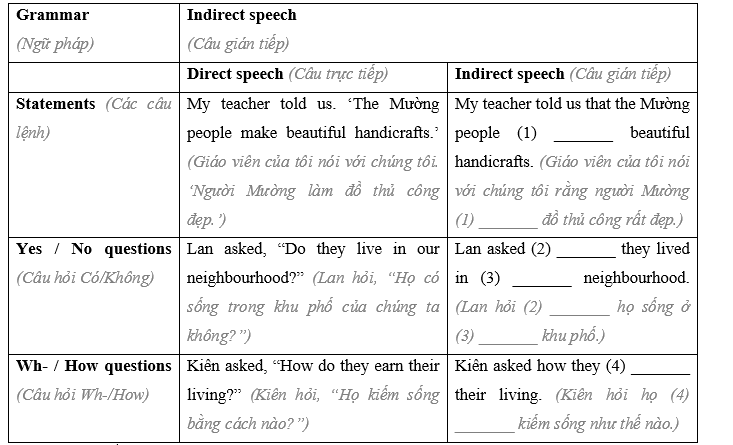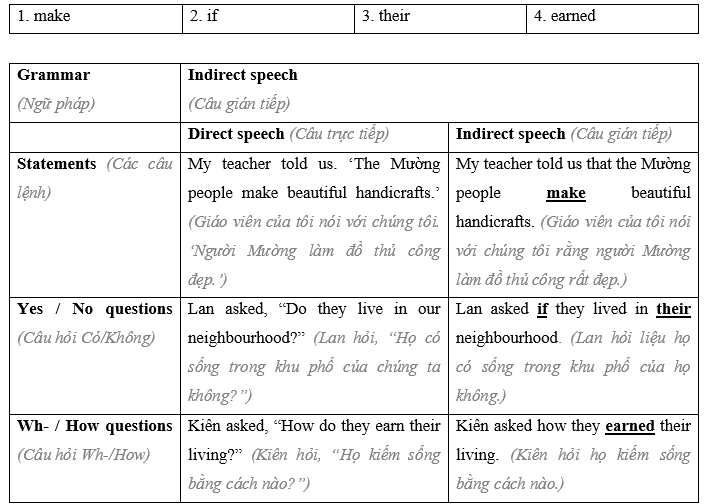Tiếng Anh 8 Unit 7 7.2 Grammar1. Read the listen to the dialogue. Tick (✓) the true statements. 2. Complete the examples in the Grammar box using the correct form. 3. Find one mistake in each of the following sentences. 4. Ms. Nguyên gave a lecture to her class about the Tày ethnic group. Change them to indirect speech. 5. Work in groups of three. Student A: Describe an ethnic minority group in Việt Nam. Student B: Report the sentence to student C. Take turns. GÓP Ý HAY - NHẬN NGAY QUÀ CHẤT Gửi góp ý cho HocTot.Nam.Name.Vn và nhận về những phần quà hấp dẫn
Lựa chọn câu để xem lời giải nhanh hơn
Bài 1 1. Read the listen to the dialogue. Tick (✓) the true statements. (Đọc đoạn nghe đoạn đối thoại. Đánh dấu (✓) vào những câu đúng.) Mother: What are you studying, Thu? Thu: I’m researching the Mường people with Lan and Kiên. My teacher said their way of living was quite different from ours. Lan asked if they lived in our neighbourhood. Mother: No, most of them live in the mountainous regions. They live in stilt houses. Thu: I see. Kiên asked how they earned their living. Mother: Well, I think they farm rice and corn as well as collect mushrooms and honey from the forests. Thu: My teacher told us that they made very beautiful handicrafts. 1. ☐ The Mường people live a different life from Thu’s family. (Người Mường sống khác gia đình Thu.) 2. ☐ Lan thinks there are Mường people living in her neighbourhood. (Lan nghĩ rằng có người Mường sống trong khu phố của cô ấy.) 3. ☐ Lan and Kiên live in stilt houses in a mountainous area. (Lan và Kiên sống trong ngôi nhà sàn ở vùng núi.) 4. ☐ The Mường people grow corn and rice to earn their living. (Người Mường trồng ngô, lúa để mưu sinh.) 5. ☐ Thu’s family collects honey and mushrooms from the forests. (Gia đình Thu đi lấy mật và nấm trong rừng.) 6. ☐ The Mường people make beautiful handicrafts. (Người Mường làm đồ thủ công rất đẹp.) Phương pháp giải: Tạm dịch: Mẹ: Con đang học gì vậy Thu? Thu: Con đang nghiên cứu về người Mường với Lan và Kiên mẹ ạ. Giáo viên của con nói rằng cách sống của họ khá khác biệt với chúng ta. Lan hỏi họ có sống trong khu phố của chúng ta hay không. Mẹ: Không, hầu hết họ sống ở vùng núi. Họ sống trong những ngôi nhà sàn. Thu: Vâng con hiểu rồi. Kiên hỏi họ kiếm sống bằng cách nào. Mẹ: Chà, mẹ nghĩ họ trồng lúa và ngô cũng như hái nấm và mật ong rừng. Thu: Cô giáo của con nói với chúng con rằng họ làm đồ thủ công rất đẹp. Lời giải chi tiết: Những câu đúng: 1, 4, 6 1. The Mường people live a different life from Thu’s family. (Người Mường sống khác gia đình Thu.) Thông tin: My teacher said their way of living was quite different from ours. (Giáo viên của con nói rằng cách sống của họ khá khác biệt với chúng ta.) 4. The Mường people grow corn and rice to earn their living. (Người Mường trồng ngô, lúa để mưu sinh.) Thông tin: I think they farm rice and corn... (Mẹ nghĩ là họ trồng lúa và ngô...) 6. The Mường people make beautiful handicrafts. (Người Mường làm đồ thủ công rất đẹp.) Thông tin: My teacher told us that they made very beautiful handicrafts. (Giáo viên của con nói rằng họ làm để thủ công rất đẹp.) Bài 2 2. Complete the examples in the Grammar box using the correct form. (Hoàn thành các ví dụ trong hộp Ngữ pháp bằng cách sử dụng đúng mẫu.)
Lời giải chi tiết:
Bài 3 3. Find one mistake in each of the following sentences. (Tìm một lỗi sai trong mỗi câu sau.) 1. Mai said some farmers in Việt Nam still use traditional farming practices. 2. Đào tell us that her mother wore her traditional costume to Bắc Hà Market. 3. My teacher said their traditional costumes are very colourful. 4. People asked do we had some H’mông handicrafts. 5. Thúy said it is difficult to live in the mountainous regions 10 years before. Lời giải chi tiết:
1. Mai said some farmers in Việt Nam still used traditional farming practices. (Mai cho biết một số nông dân ở Việt Nam vẫn sử dụng các phương thức canh tác truyền thống.) 2. Đào told us that her mother wore her traditional costume to Bắc Hà Market. (Đào nói với chúng tôi rằng mẹ cô ấy mặc trang phục truyền thống của mình đến chợ Bắc Hà.) 3. My teacher said their traditional costumes were very colourful. (Giáo viên của tôi nói rằng trang phục truyền thống của họ rất sặc sỡ.) 4. People asked if we had some H’mông handicrafts. (Mọi người hỏi chúng tôi có một số đồ thủ công của người H’mông không.) 5. Thúy said it was difficult to live in the mountainous regions 10 years before. (Thúy nói 10 năm trước sống ở miền núi rất khó khăn.) Bài 4 4. Ms. Nguyên gave a lecture to her class about the Tày ethnic group. Change them to indirect speech. (Cô Nguyên giảng bài cho cả lớp về dân tộc Tày. Chuyển chúng sang lời nói gián tiếp.) 1. The Tày are the largest ethnic minority group in Việt Nam. (Người Tày là dân tộc thiểu số đông nhất ở Việt Nam.) Ms. Nguyên said ___________________________________. 2. They mainly live in our northern provinces. (Họ sống chủ yếu ở các tỉnh phía Bắc nước ta.) Ms. Nguyên said ___________________________________. 3. Do they grow rice and fruit to earn their living? (Họ có trồng lúa và hoa quả để kiếm sống không?) Students asked _____________________________________. 4. Who do Tày parents live with? (Bố mẹ Tày sống với ai?) Students asked _____________________________________. 5. More children in the Tày group will have a bright future in the next 10 years. (Nhiều trẻ em dân tộc Tày có tương lai tươi sáng trong 10 năm tới.) Ms. Nguyên said ____________________________________. Lời giải chi tiết: 1. Ms. Nguyên said the Tày were the largest ethnic minority group in Việt Nam. (Bà Nguyên cho biết người Tày là dân tộc thiểu số lớn nhất ở Việt Nam.) 2. Ms. Nguyên said they mainly lived in our northern provinces. (Bà Nguyên cho biết họ sống chủ yếu ở các tỉnh phía Bắc nước ta.) 3. Students asked if they grew rice and fruit to earn their living. (Học sinh hỏi họ có trồng lúa và trồng cây ăn quả để kiếm sống không.) 4. Students asked who Tày parents lived with. (Học sinh hỏi bố mẹ Tày ở với ai.) 5. Ms. Nguyên said more children in the Tày group would have a bright future in the next 10 years. (Cô Nguyên cho biết sẽ có thêm nhiều trẻ em dân tộc Tày có tương lai tươi sáng trong 10 năm tới.) Bài 5 5. Work in groups of three. Student A: Describe an ethnic minority group in Việt Nam. Student B: Report the sentence to student C. Take turns. (Làm việc trong nhóm ba. Học sinh A: Mô tả một nhóm dân tộc thiểu số ở Việt Nam. Học sinh B: Báo cáo câu hỏi cho học sinh C. Thay phiên nhau.) A: The Mường people live in stilt houses. (A: Người Mường ở nhà sàn.) B: A said the Mường people lived in stilt houses. (B: A nói người Mường ở nhà sàn.) Lời giải chi tiết: A: The Mường people make beautiful handicrafts. (A: Người Mường làm đồ thủ công rất đẹp.) B: A said the Mường people made beautiful handicrafts. (B: A nói người Mường làm đồ thủ công rất đẹp.)
|
















